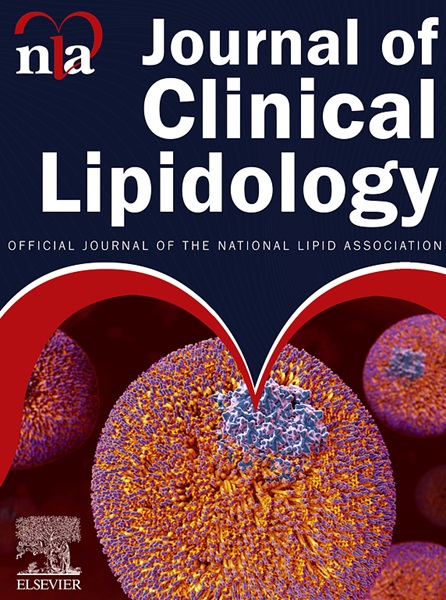obicetrapib的降脂效果:一项全面的系统评价和荟萃分析。
IF 4.6
3区 医学
Q2 PHARMACOLOGY & PHARMACY
引用次数: 0
摘要
背景:Obicetrapib是下一代口服选择性胆固醇酯转移蛋白抑制剂,已知可显著影响致动脉粥样硬化脂蛋白,包括低密度脂蛋白胆固醇(LDL-C)、载脂蛋白B (ApoB)、非高密度脂蛋白胆固醇(Non-HDL-C)和脂蛋白(a) [Lp(a)]。目的:在现有证据的基础上评价奥比西拉比的降脂效果。方法:根据系统评价和荟萃分析指南的首选报告项目起草本系统评价。我们进行了全面的文献检索,以确定评估obicetrapib与安慰剂相比降脂效果的随机临床试验。使用了固定效应和随机效应模型。结果:本分析纳入5项随机临床试验(n = 288例)。接受obicetrapib治疗的患者LDL-C显著降低(平均差异[MD]: 41.4% [95% CI: 45.7至-37.1];我²:6%),飞机观测(MD: 26.5%(95%置信区间CI: 31.3 - -21.6);我²:45%)和Non-HDL-C (MD: 34.5%(95%置信区间CI: 37.0 - -31.6);I²:80%)与接受安慰剂的患者相比。此外,obicetrapib组的HDL-C水平显著升高(MD: 157.4% [95% CI: 142.2至172.6];我²:69%)。虽然两组之间甘油三酯水平无显著差异,但奥比西拉比治疗显著降低了Lp(a)水平(MD: 39.5% [95% CI: 54.6至-24.3];我²:67%)。结论:Obicetrapib可显著降低致动脉粥样硬化的关键脂蛋白,包括LDL-C、ApoB、Non-HDL-C和Lp(a)。需要进一步的调查来评估其对心血管风险的影响。本文章由计算机程序翻译,如有差异,请以英文原文为准。
Lipid-lowering efficacy of obicetrapib: A comprehensive systematic review and meta-analysis
BACKGROUND
Obicetrapib is a next-generation, oral, selective cholesteryl ester transfer protein inhibitor known to significantly affect atherogenic lipoproteins, including low-density lipoprotein cholesterol (LDL-C), apolipoprotein B (ApoB), nonhigh-density lipoprotein cholesterol (Non-HDL-C), and lipoprotein(a) [Lp(a)].
OBJECTIVE
To evaluate the lipid-lowering efficacy of obicetrapib based on available evidence.
METHODS
This systematic review was drafted according to Preferred Reporting Items for Systematic Reviews and Meta-Analyses guidelines. A comprehensive literature search was conducted to identify randomized clinical trials assessing the lipid-lowering effects of obicetrapib compared to placebo. Fixed and random-effects models were used.
RESULTS
Five randomized clinical trials (n = 288 patients) were included in this analysis. Patients treated with obicetrapib exhibited significantly greater reductions in LDL-C (mean difference [MD]: 41.4% [95% CI: 45.7 to −37.1]; I²: 6%), ApoB (MD: 26.5% [95% CI: 31.3 to −21.6]; I²: 45%), and Non-HDL-C (MD: 34.5% [95% CI: 37.0 to −31.6]; I²: 80%) compared to those receiving a placebo. Additionally, HDL-C levels were significantly higher in the obicetrapib group (MD: 157.4% [95% CI: 142.2 to 172.6]; I²: 69%). While triglyceride levels did not differ significantly between the 2 groups, Lp(a) levels were notably reduced with obicetrapib treatment (MD: 39.5% [95% CI: 54.6 to −24.3]; I²: 67%).
CONCLUSION
Obicetrapib is associated with significant reductions in key atherogenic lipoproteins, including LDL-C, ApoB, Non-HDL-C and Lp(a). Further investigation is needed to assess its impact on cardiovascular risk.
求助全文
通过发布文献求助,成功后即可免费获取论文全文。
去求助
来源期刊
CiteScore
7.00
自引率
6.80%
发文量
209
审稿时长
49 days
期刊介绍:
Because the scope of clinical lipidology is broad, the topics addressed by the Journal are equally diverse. Typical articles explore lipidology as it is practiced in the treatment setting, recent developments in pharmacological research, reports of treatment and trials, case studies, the impact of lifestyle modification, and similar academic material of interest to the practitioner.
Sections of Journal of clinical lipidology will address pioneering studies and the clinicians who conduct them, case studies, ethical standards and conduct, professional guidance such as ATP and NCEP, editorial commentary, letters from readers, National Lipid Association (NLA) news and upcoming event information, as well as abstracts from the NLA annual scientific sessions and the scientific forums held by its chapters, when appropriate.

 求助内容:
求助内容: 应助结果提醒方式:
应助结果提醒方式:


